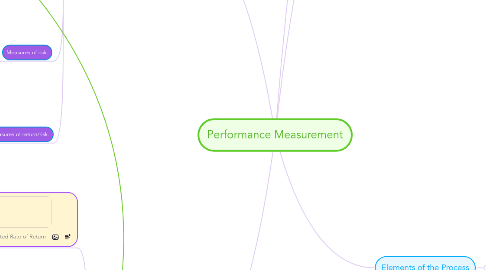
1. Categories of Measures
1.1. Measures of balance and structure.
1.1.1. At portfolio and sector levels.
1.1.2. Composition by attributes:
1.1.2.1. Value.
1.1.2.2. Amount of space.
1.1.2.3. Number of units.
1.1.2.4. Location.
1.1.2.5. Freehold/leasehold split.
1.1.2.6. Characteristics of tenant.
1.2. General measures, return and capital measures.
1.2.1. Efficiency of income collection.
1.2.2. Income yield on cost.
1.2.3. Income yield on value.
1.2.4. Rate of income appreciation.
1.2.5. Reversionary potential.
1.2.6. Rate of capital appreciation
1.3. Measures of total return
1.3.1. Time weighted total return.
1.3.1.1. Recommended by the Bank Administration Institute in the USA (BAI) in 1968.
1.3.2. Money weighted total return.
1.3.2.1. Recommended by the Society of Investment Analysts (SIA) in 1972.
1.3.3. Internal rate of return.
1.3.4. Financial management rate of return
1.4. Measures of risk.
1.4.1. Variability:
1.4.1.1. Standard deviation.
1.4.1.2. Variance.
1.4.2. Volatility:
1.4.2.1. Beta Coefficient
1.4.3. Historic risk factor.
1.4.4. Risk scoring.
1.5. Measures of return/risk.
1.5.1. Reward to variability:
1.5.1.1. Coefficient of variation.
1.5.1.2. Sharpe Index
1.5.1.2.1. [ (RI -RFRR)/Variance ]
1.5.2. Reward to Volatility:
1.5.2.1. Treynor Index
1.5.2.1.1. [ (RI -RFRR)/Beta]
1.5.3. Jenson Index.
2. MWRR vs TWRR
2.1. Money Weighted Rate of Return
2.1.1. “…The discount rate which equates the sum of all realised cash flows and capital value at the end of the holding period to the initial capital outlay or capital value at the beginning.”
2.1.2. is a measure of absolte return earned by taking account of cash flowing into and out the fund
2.1.3. MWRR is variant of the internal rate of return
2.2. Measuring total returns: Time Weighted Rate of Return (TWRR)
2.2.1. Is the geometric mean of rates of return achieved over each sub-period.
2.2.2. It takes into account both the change in capital value and the income received during the measurement periods.
2.2.3. Is calculated by taking the nth root of the product of all the intermediate returns.
2.2.4. Calculate return of each sub period
2.2.4.1. change in capital value in sub-period+income received (during sub period)/capital value at the start of sub-period
2.2.4.2. TWRR=nth root of ((1+r1)*(1+r2)*(1+rn))-1
2.2.4.2.1. r1, rn is combination return of capital appreciation and income received fro individual sub period 1 to n
2.2.5. It is a measure of the absolute return earned by taking account of cash flowing into and out the fund.
2.2.6. MWRR is a variant of the internal rate of rerun (IRR).
2.3. result
2.3.1. If MWRR > TWRR, then the timing of investment into and out of the fund has been good.
2.3.2. If MWRR < TWRR, the timing of investment into and out of the fund has been poor.
2.3.3. The difference between MWRR and TWRR provides a measure of investor’s timing skill.
3. Purposes
3.1. Assess the ability effectiveness and efficiency of management.
3.2. Improve future performance.
3.3. Enable comparison with competitors.
4. Principal Objectives
4.1. Measure past performance in terms of risk and return.
4.2. Assess future performance in quantitative terms.
4.3. Measure portfolio balance and structure.
4.4. Compare past performance against chosen standards.
4.5. Identify whether past performance is good or bad.
4.6. Provide explanations for good and/or bad performance.
4.7. Identify factors that need to be tackled to improve performance.
5. Elements of the Process
5.1. Measurement
5.1.1. Is an integral part of performance analysis.
5.1.2. Provides quantitative measures of portfolio performance.
5.1.3. Provides basis for further analysis.
5.1.4. May be retrospective or prospective.
5.1.5. May be internal or external.
5.1.6. Measure past performance at various levels:
5.1.6.1. Individual property.
5.1.6.2. Portfolio sector.
5.1.6.3. Property portfolio.
5.1.6.4. Entire portfolio.
5.1.6.5. External benchmarks.
5.1.7. May focus on particular attributes of the investment.
5.2. Components
5.2.1. Identify the components of portfolio performance.
5.2.2. Distinguish between performance due to:
5.2.2.1. General market/economy.
5.2.2.2. Regional characteristics.
5.2.2.3. Unique characteristics.
5.3. Factors
5.3.1. Identify the factors affecting performance:
5.3.1.1. Market factors.
5.3.1.2. Localised factors.
5.3.1.3. Unique factors.
5.4. Expectations
5.4.1. Assess future movements in the factors which affect performance, namely:
5.4.1.1. Unique
5.4.1.2. Localised.
5.4.1.3. Market.
5.4.2. In the light of expectations consider future performance of:
5.4.2.1. Individual properties.
5.4.2.2. Property sectors and other attributes.
5.4.2.3. Property portfolio.
5.4.2.4. Entire portfolio
5.4.2.5. Benchmarks.
5.4.2.6. Competitors.
5.5. Application
5.5.1. Make and implement investment decisions in order to improve future performance.
5.5.2. Decisions may be:
5.5.2.1. Strategic.
5.5.2.2. Operational.
5.5.2.3. Tactical.
5.5.3. Decisions may concern:
5.5.3.1. Changes in management.
5.5.3.2. Investment/disinvestment.
5.5.3.3. Refurbishment/redevelopment.
5.5.3.4. Portfolio balance and structure
5.5.3.5. Restructuring.
